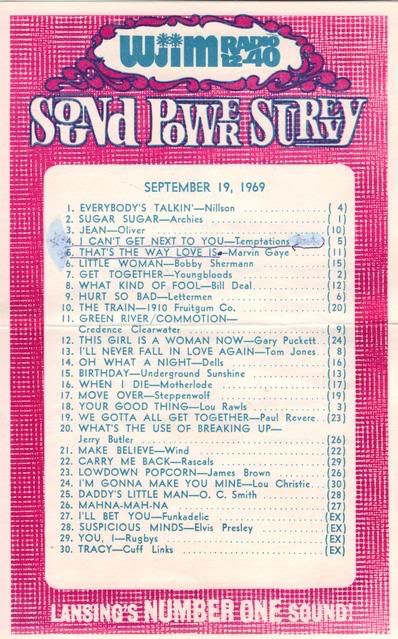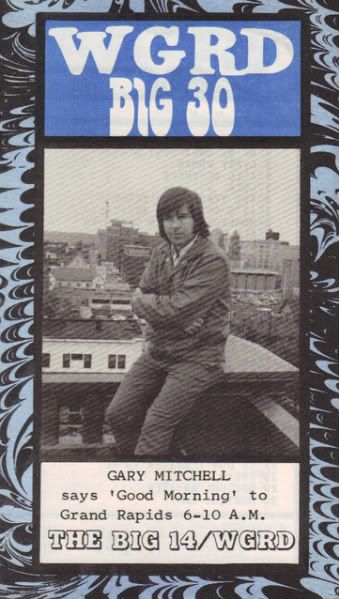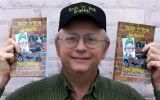
Radio surveys, like this one from WJIM in
Lansing, were an important component in the Top
40 format.
By STEVE SEYMOUR
Radio surveys, which ranked the Top 40 songs at local stations, are an under-appreciated part of pop music history.
Published weekly, the listings were issued from the late 1950s to the early 1980s, with the practice peaking in the late 1960s.
The surveys were usually distributed at retail record outlets where customers would buy the latest 45 rpm singles.
Billboard magazine actually compiled its Hot 100 singles chart from these radio surveys and data collected from vinyl sellers until a computer-based method was originated in 1991.
Because a record's progress could be tracked, many music fans collected the weekly surveys, hoping their favorite song would eventually rule the Top 40.
The surveys were contained on a single sheet of paper and listed the radio station's top songs along with their previous week's chart position.
Some leaflets were simple, showing the list of records, date and station call letters. Others contained photographs, advertising and program notes, too.
Radio surveys came in various sizes, some being folded and most having colorful graphics to grab the attention of the young listeners who also spent their spare cash buying singles and albums.
I've long been fascinated by these little publications and picked them up whenever I was in a store which sold records.
Smaller radio stations didn't usually produce weekly surveys, but they were quite common in larger markets where the broadcast business was more competitive.
For years, I've kept three examples from the Lansing area which just happen to illustrate the variety of radio surveys published at the time.
The capital city's WJIM, AM 1240, printed "Sound Power Survey" every seven days. The Sept. 19, 1969 edition put Nilsson at No. 1 with "Everybody's Talkin'." Measuring just four and one-half by seven inches, the flyer also promoted Michigan State University football games aired on the station.
Named after the son of original station owner Harold Gross, WJIM boosted "Lansing's Number One Sound."
The survey for WVIC in nearby East Lansing, meanwhile, was more elaborate. The issue dated Jan. 17, 1970 listed "Jennifer Tompkins" by the group Street People in the top spot. WVIC, AM 730 and FM 94.9, was East Lansing's dominant Top 40 station. Their folded survey opened to reveal the "Big 30" singles, "Hit Bounds" and "Big 5 Albums." The back carried an advertisement for the album "Music From Big Pink" by The Band.
WVIC's survey also publicized concerts at a rock bar called Grandmother's, including a Feb. 1, 1970 show which featured Scorpion and Pitche Blende.
WBRS, the first radio station on the MSU campus, on the other hand, just compiled the hits on a eight and one-half by 11 inch handbill. The list dated Jan. 30, 1970 put "Blowin' in the Wind" by the Fifth Dimension as the top song.
Another undated WBRS survey tagged "Something's Burning" by Kenny Rogers and the First Edition at No. 1. WBRS, AM 820, which stood for Brody Radio Service, was affiliated with the ABC radio network.
Former Upper Peninsula resident Clark Sullivan also put away a few radio surveys back in the late 1960s. Sullivan, a founder and lead singer of the Marquette-based Excels, was tracking the success of "Little Innocent Girl," one of five singles the band released on the Carla label.
For the week of July 19, 1968, WTRU, AM 1600, in Muskegon, put the song at No. 20, up six positions from the previous week. WTRU was an influential contemporary hits station which waned with the onset of FM stations in the 1970s.
On a survey dated July 17, 1968, WVMO in Monroe put "Innocent Little Girl" at No. 8. WVMO, FM 98.3, which stood for Voice of Monroe, had signed on the air the previous summer. (Both WTRU and WVMO named "Turn Around, Look at Me," by the Vogues, as their No. 1 song.)
The Excels did even better with their record at WKNX, AM 1210, the leading Top 40 hit music station in Saginaw. On the Aug. 9, 1968 survey, the song was listed at No. 3 for the second week, behind "People Got to be Free," by the Rascals at No. 2, and "Born to be Wild" by Steppenwolf at No. 1.
By Aug. 16, the Excels' song climbed to No. 2, while "Light My Fire," by Jose Feliciano, leapfrogged into the top spot.
While "Little Innocent Girl," drew considerable interest in lower Michigan, it did not make the national Billboard Hot 100 chart.
Iron Mountain native Joe Giannunzio also collected a few radio surveys when he was working as a disc jockey at WGRD in Grand Rapids under the professional name Gary Mitchell.
WGRD, AM 1410, was a pioneer in the Top 40 format, beginning such programming in 1959. The call letters stood for Grand Rapids day time, since the business was only licensed to broadcast during daylight hours.
Nicknamed the "Big 14," WGRD put considerable effort into its radio surveys. Although the folded brochures were just three and one-half by six inches in size, they featured black & white photographs, colorful psychedelic borders and advertisements, in addition to the song listings, referred to as the "Big 30."
"The WGRD 'Big 30' is an unbiased estimate of the relative popularity of songs in the Grand Rapids area, based, in part upon local sales and listener requests," an announcement in each issue declared.
Three installments of the station's survey featured photos of Giannunzio on the cover. Issue 135, dated Aug. 12, 1970, ranked "Make It With You" by Bread at No. 1 and also carried an ad for Coke.
Radio survey 147 listed "I Think I Love You" by the Partridge Family in the premier position on Nov. 4, 1970, but also promoted a "Heavy!" SRC concert in an ad on the back cover.
Edition 158, dated Jan. 20, 1971, had "One Bad Apple," by the Osmonds at the top spot. The back cover advertised a concert featuring Mike Quatro and his Jam Band along with an all-girl rock group called Cradle.
Although radio surveys were popular for years, they fell from favor in the late 1970s, ending an era in broadcasting history.
Today, radio aficionados and pop culture historians increasingly value those old surveys for the detailed glimpse they offer into radio's past. They're still fun to look at, too.


 I've enjoyed rock music and writing since I was a teenager in the 60s. I feel lucky to have been around when rock's greatest stars created their most enduring hits. At the same time I found I enjoyed writing, as well. I worked on my high school newspaper and magazine, was editor of several college publications and earned a bachelor's degree from Central Michigan University in 1973. I worked for the daily newspaper in my hometown after graduating, becoming managing editor after a few years. By the 1980s, I moved into public relations. In 1985, my wife Sue and I opened a retail music store, The Record Rack, which we still own. Rock 'n' roll has been integral to me and for the last 2O years I've been earning my living from it even though I don't have a musical bone in my body. In recent years, I've also I edited a small local magazine and launched a micro FM radio station. Now, I'm finally combining my love of writing and rock 'n' roll. I can't sing a note, but I know what I like. I'll tell you all about it when you read on. I hope you have as much enjoyment reading these installments as I've had writing them.
I've enjoyed rock music and writing since I was a teenager in the 60s. I feel lucky to have been around when rock's greatest stars created their most enduring hits. At the same time I found I enjoyed writing, as well. I worked on my high school newspaper and magazine, was editor of several college publications and earned a bachelor's degree from Central Michigan University in 1973. I worked for the daily newspaper in my hometown after graduating, becoming managing editor after a few years. By the 1980s, I moved into public relations. In 1985, my wife Sue and I opened a retail music store, The Record Rack, which we still own. Rock 'n' roll has been integral to me and for the last 2O years I've been earning my living from it even though I don't have a musical bone in my body. In recent years, I've also I edited a small local magazine and launched a micro FM radio station. Now, I'm finally combining my love of writing and rock 'n' roll. I can't sing a note, but I know what I like. I'll tell you all about it when you read on. I hope you have as much enjoyment reading these installments as I've had writing them.


No comments:
Post a Comment